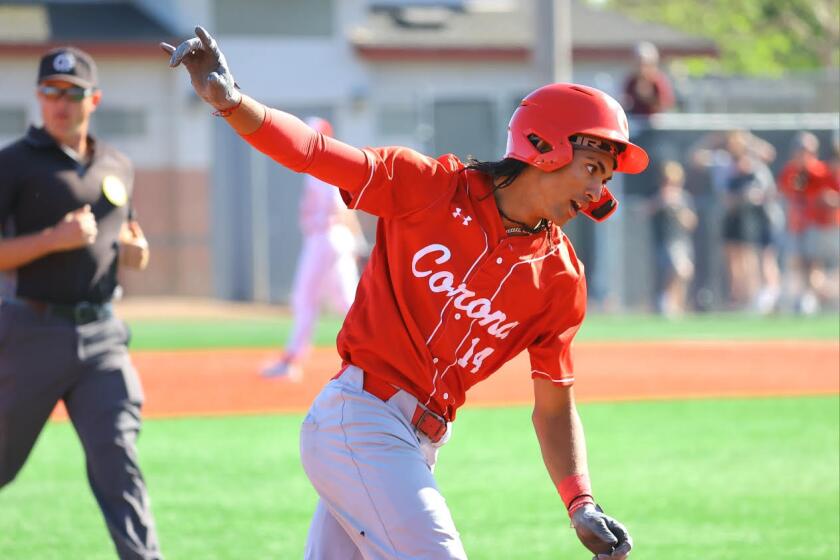Recruits’ Admission Links Cal Lutheran to NCAA Infractions
- Share via
A prospective football player has admitted participating in practices with the Cal Lutheran University team during a visit to the school in April. Such an action would violate NCAA rules, a representative of the NCAA said.
Two other prospective players are said to have also practiced on campus visits last spring.
Jim Bees, a quarterback who played at San Bernardino Valley College the past two years, said he “took snaps and threw to receivers running pass patterns” while visiting Cal Lutheran on April 23 and 24. Bees has since accepted a full scholarship to attend CLU in the fall and is in the process of being admitted.
Butch Worley, an administrator with the NCAA, said Friday that the tryouts violated NCAA bylaw 1-6 (d). Titled “Tryouts,” the bylaw states: “No member institution, on its campus or elsewhere, shall conduct or have conducted in its behalf any athletics practice session, tryout or test at which one or more prospective student-athletes reveal, demonstrate or display their abilities in any phase of any sport.”
Because Bees contacted CLU first, Coach Bob Shoup believes Bees may not have been a student athlete under the NCAA’s definition. Article three, Section 1 defines a student athlete as “ . . . a student whose matriculation was solicited by a member of the athletics staff or other representative of athletics interests with a view toward the student’s ultimate participation in the intercollegiates athletics program.”
While he admits Bees practiced with the team, Shoup believes the NCAA rule is confusing. “It may have been a violation but I’m not convinced,” Shoup said. “By my interpretation, granted I’m not on the rules committee, it was not a violation because Bees is a walk-on. Obviously the interpretation is the NCAA’s and not ours.”
CLU President Jerry Miller is on vacation and was unavailable for comment, but a university spokesman had a prepared statement pertaining to the violations, which read: “We have heard rumors and allegations of violations of university policy. We are checking into those violations by using standard university procedure.”
Bees said he visited Cal Lutheran on successive weekends and practiced with the team. “I threw pass patterns,” he said, “and stepped aside when the team had full contact drills. I went up there planning to work out.”
Tom Bonds, CLU’s senior quarterback, said that Bees practiced on consecutive days.
“Me and him played catch, then as I moved along through drills he followed me,” Bonds said. “He did everything. When he started taking snaps and jumped in on 7-on-7 drills, that was a little strange.”
Bonds said he and the rest of the players were not aware that the tryout was a violation.
“It was kind of no big deal,” he said. “Coach Shoup introduced him to the team after practice.”
In addition to Bees’ tryout, freshmen wide receivers Scott Nagel and Joey Woods had tryouts on separate occasions.
“I caught a few balls from Bonds,” said Nagel, who attended Northglen High in Broomfield, Colo. “I was all dressed up in a suit and tie and just messed around.” Woods was unavailable for comment.
“I played catch with both of them,” Bonds said. “They may have run a couple of pass patterns.”
Said Shoup: “I’m not sure about what Nagel and Woods did. We have a lot of recreational activities going on and they may have played catch with Tommy Bonds.”
Although a player throwing or catching some passes with prospective teammates may seem innocuous, the NCAA bylaw is designed to protect recruits.
“The reason visits are allowed is so a prospect can evaluate the school, not so the school can grill him in a tryout,” Worley said. “It is not a time for the school to decide whether or not they want the kid.”
If, for example, a player is not impressive in a tryout, the coach could have declined to offer him a scholarship based on what he saw. That apparently was not the case.
Bees (6-1, 180) passed for 2,400 yards and 12 touchdowns for San Bernardino Valley College last season. Statistics and game films are usually enough for a coach to decide whether he wants the player. Bees, however, was eager to impress Shoup in person.
“I asked Coach Shoup over the phone if I could visit,” Bees said. “He said, ‘By all means, come on up.’ He told me when spring workouts were.
“No one ever said anything about it being illegal. If I had known that, I wouldn’t have done it.”
Worley did not comment on the severity of a penalty for the alleged violations. In a similar case involving an illegal tryout of a player by Cal State Northridge in December, 1984, the school was publicly reprimanded and the coach, Tom Keele, was prohibited from recruiting off campus for one month. Keele was fired two weeks before the violations surfaced publicly, although CSUN officials and Keele denied a connection.
Despite the evidence, Shoup maintains he wasn’t hiding anything. “If we were going to publicize something we’d have put an ad in the newspaper,” Shoup said. “Tryouts at 2 p.m.”
More to Read
Get our high school sports newsletter
Prep Rally is devoted to the SoCal high school sports experience, bringing you scores, stories and a behind-the-scenes look at what makes prep sports so popular.
You may occasionally receive promotional content from the Los Angeles Times.







